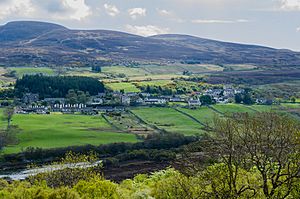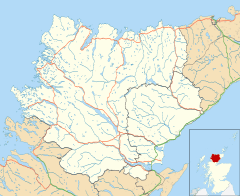Tongue, Sutherland facts for kids
Quick facts for kids Tongue
|
|
|---|---|
 Tongue, Highland, Scotland |
|
| Population | 564 (2011 census) |
| OS grid reference | NC591570 |
| • Edinburgh | 180 mi (290 km) |
| • London | 510 mi (821 km) |
| Council area | |
| Lieutenancy area | |
| Country | Scotland |
| Sovereign state | United Kingdom |
| Post town | LAIRG |
| Postcode district | IV27 |
| Dialling code | 01847 |
| Police | Northern |
| Fire | Highlands and Islands |
| Ambulance | Scottish |
| EU Parliament | Scotland |
| UK Parliament |
|
| Scottish Parliament |
|
Tongue (called Tunga in Scottish Gaelic) is a small village located on the coast in the northwest of Highland, Scotland. It sits on the eastern shore of the Kyle of Tongue, a long sea inlet. To the north are the mountains Ben Hope and Ben Loyal. The village is found along the A836 route.
Tongue is the main village among several small farming communities called crofting townships. These include Coldbackie, Dalharn, Blandy, and the harbour of Scullomie. In Tongue, you can find a youth hostel, a craft shop, a general store, a garage, a bank, a post office, and two hotels. A bridge and causeway built in 1971 connect Tongue to the western side of the Kyle.
Contents
What's in a Name?
The name Tongue might make you think of the shape of the Kyle of Tongue. However, the name actually comes from an Old Norse word. It describes a piece of land that looks like a "spit" or "tongue" sticking out into the water. This piece of land is a natural formation left by a glacier. It forms the eastern part of the Kyle of Tongue causeway.
In Scottish Gaelic, the village is called Tunga. The sea inlet itself is called Caol Thunga. The village was also known as Ceann Tàile and, a long time ago, Circeabol.
A Look at Tongue's Past
The area around Tongue has a rich history. It was a meeting point for different groups of people, including the Gaels, Picts, and Vikings.
Clan Mackay's Home
Tongue House is the historic home of the Clan Mackay. They moved here after leaving Castle Varrich. The ruins of Castle Varrich are a popular place for tourists to visit. This castle was built in the eleventh century. A battle between two parts of the clan, called the Battle of Drumnacoub, happened nearby around 1427 to 1433.
A Battle at Sea
In 1746, a major event took place near Tongue. A Jacobite ship carrying treasure was chased by two ships from the Royal Navy. The Jacobite crew tried to sneak ashore with their gold. But they were caught by the Navy, who were helped by local people loyal to King George II. This loss of treasure was a big blow to Bonnie Prince Charlie just before the Battle of Culloden.

Changes and Poetry
During the Highland Clearances, many people were forced to leave their homes in other parts of Sutherland. Some of them moved to Tongue. A famous Scottish Gaelic poet, Ewen Robertson (1842–95), lived in Tongue his whole life. He is known for his song "My curses on the Border sheep." This song made fun of people like the Duchess of Sutherland. Today, there is a monument in Tongue to remember Ewen Robertson.
Famous People from Tongue
- George W. Campbell was born in Tongue. He later moved to the United States. There, he became a U.S. Senator for Tennessee, a Secretary of the Treasury, and a diplomat.
- Professor Anson Mackay, an environmental scientist, grew up in a farming family in Tongue. He lived there until he went to university.
Images for kids
See also
 In Spanish: Tongue para niños
In Spanish: Tongue para niños



